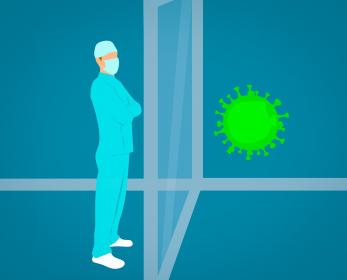NGST - Next Generation Protective Textiles
- Efficient Production of Novel, High-Quality Infection-Protective Textiles
Considerable shortages of protective textiles, especially respirators, occurred during the SARS-CoV-2 pandemic, which were exacerbated by the lack of sufficient production capacity in Germany and the EU at the time. Short-term retooling at EU companies as well as importing goods often did not lead to success, as these protective textiles were of highly variable quality, which had a negative impact on safety.
The "Next Generation Protective Textiles" initiative aims to remedy this situation by researching new approaches for the production of high-quality protective textiles.
The "NGST" project is divided into several subtasks
The project includes:
- qualified selection of basic materials
- studies on up-scaling to create the conditions for a rapid expansion of production capacities
- development of novel antiviral coatings
- comprehensive biological and material science analysis to verify the improved properties and also to open up new methods of quality control.
The protective textiles to be developed in the project have a wide range of applications beyond use in the medical field and in civil protection. In principle, wherever immediate cleaning and disinfection are difficult or special filtration tasks are necessary, such as in mobile or stationary filter systems for air purification or for individual personal protection.
In this project, the Fraunhofer IGCV is researching the development of a manufacturing process for nonwovens as a basis for infection protection and filtration media based on wet nonwoven technology. Compared to the state of the art (meltblown technology), this is potentially characterised by significantly increased production capacities as well as increased flexibility with regard to material variety. The main challenges here are the very high quality requirements based on low basis weights for processing the finest possible micro-staple fibres..
Pursuing novel approaches to increase quality and productivity in the production of protective textiles
The aim is to provide optimised nonwoven materials as a starting material for subsequent antiviral coatings, and to assess and demonstrate the high technological potential of wet nonwoven technology in this field of application.
For this purpose, an existing pilot wetlaid nonwoven line was specifically modified on a pilot plant scale. This makes it possible to produce nonwoven materials from micro-staple fibres in the required very high quality in terms of uniformity, basis weight, blending and thickness profile with high reproducibility. A standard PP nonwoven was used as a comparison system, which was produced according to the current state of the art using meltblown technology. In addition to the PP comparison variants, however, the processing of PLA, viscose and PET staple fibres, among others, was also investigated. The focus here is on maximum fibre fineness (microfibres) in each case in order to achieve the largest possible specific fibre surface or effective area in the nonwoven. In order to emphasise the significantly increased flexibility of wetlaid technology, particularly innovative variants based on modified bi-component fibres with maximised fibre surface area as well as split fibres are also being conceptually tested.
In addition to aspects of direct material and process development, the scale of the pilot plant provides a comprehensive data basis for estimating a later scaling up to an industrial series. This should create a technological starting point for the ramp-up of an efficient, national production of fleece-based infection control materials based on wet-laying technology.
Fraunhofer Institute for Casting, Composite and Processing Technology IGCV


